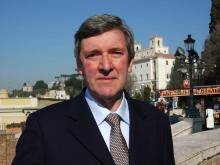Pope Francis returns to South America on July 5; and, consistent with his preferential option for the poor, he has chosen to visit the three poorest countries in the region: Ecuador, Bolivia and Paraguay.
This is his second visit to the continent of his birth since becoming pope, but the first of his own choosing. The visit to Rio de Janeiro for World Youth Day in July 2013 had been planned before his election; he respected that commitment but did it his way, with extraordinary results.
He has often said that one sees reality better from the periphery than from the center, and this eight day visit (July 5-12) takes him exactly there, to “the peripheries of the South American periphery.”
A majority of the population in each country is Catholic: 85 percent of Ecuador’s 15 million people, 86 percent of Bolivia’s 10 million and 70 percent of Paraguay’s seven million. All three have indigenous populations and experienced dictatorial or authoritarian regimes—especially Bolivia and Paraguay—but are now democratic. Francis’ visit to strengthen the faith of believers in lands where popular religion thrives and where the Jesuits have a glorious history, particularly with the Reductions in the last two countries, is sparking excitement and enthusiasm.
He will arrive soon after his encyclical on ecology appears. Many things in it have direct relevance for all three countries, where economic growth has been slow and a high percentage of the population is very poor. Furthermore, oil-rich Ecuador’s biodiversity is threatened. Landlocked Bolivia, with its biodiversity and varied ecosystems, suffers the consequences of deforestation in some places and needs a corridor to the sea. Paraguay is ranked as the worst country in Latin America and second worst in the world for deforestation.
Relations between church and state vary from country to country. They are easiest in Paraguay, where a former bishop, Fernando Lugo, was president (2008–12), but somewhat problematic in Bolivia. But the first Latin American pope’s visit could introduce a new warmth to those ties. He will meet with the presidents of all three countries.
He arrives in Ecuador on July 5, after a 13-hour flight from Rome, accompanied by senior Vatican officials and 70 cameramen and reporters, including America’s Vatican correspondent. Over a million people are expected to attend each of his two public Masses here: at Samanes Park, Guayaquil, and at Quito’s Bicentennial Park. On July 6 he will have lunch with the Jesuit community at Collegio Javier, Guayaquil, and on July 7 will pray in private at Quito’s famous Jesuit church, the “Iglesia de la Compañía,” and meet students at the Catholic University.
On July 8 Francis will land at Bolivia’s international airport at El Alto, the highest in the world at 13,325 feet. But he will spend less than three hours there on the advice of his doctors, because of La Paz’s altitude, 11,975 feet. That will be just enough time to meet President Evo Morales, greet the civil authorities and pray at a site near where a Spanish Jesuit priest, Luis Espinal, was assassinated in March 1980 during the military dictatorship because of his work for social justice.
From La Paz, he will travel east to Santa Cruz, where he will stay with his friend Cardinal Julio Terrazas Sandoval, the emeritus archbishop who invited him to come immediately after his election. Over the next two days, he will celebrate Mass for two million people, participate in the second World Meeting of Popular Movements, visit a reeducation center and much else.
On July 10 he is scheduled to fly to Asunción, the capital of Paraguay. He visited there twice during the military dictatorship of Alfredo Stroessner (1954–89) for a meeting of Jesuit provincials (1973) and of novice masters (1980). He knows the Paraguay-Guarani people well because many of them live in the shanty towns of Buenos Aires he frequented as archbishop.
On July 11 he will visit a children’s hospital and celebrate Mass at the Marian shrine of Caacupé. On his last day there, July 12, he will travel to Bañado Norte, the marshlands where many impoverished people live, and later celebrate Mass for three million people in the Jesuit field at Ñu Guazú Park. That afternoon, after attending a young people’s rally on the Costanera River bank, he will fly back to Rome.
He is the second pope to come here: John Paul II visited Ecuador (January 1985), Bolivia and Paraguay (May 1988).








